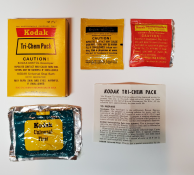Jesse K
Member
I'm a 17-year-old who loves all types of analog photography and camera building. I will soon be giving a demonstration (and possible workshop) on pinhole photography and the paper development process. I was browsing the other day when I came across the Tetenal chemistry tablets (https://tetenal.com/en/). I'm curious about the possibility of creating these types of tablets at home using my own developer, stop, and fixer formulas. Would anyone be able to enlighten me on how one would go about this, or if it is even possible? I understand that it would be time consuming to create them, but it would make it far easier to give workshops to younger students and not require me to bring multiple measuring tools. Thanks!







